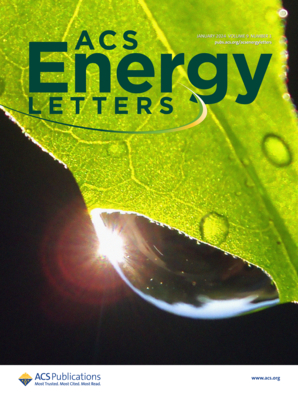无溶剂熔融加工阴极减轻聚合物基固态电池中锂阳极的不稳定性
IF 18.2
1区 材料科学
Q1 CHEMISTRY, PHYSICAL
引用次数: 0
摘要
电池组件的无溶剂制造是传统浆料加工的一个有前途的替代方案,可以降低成本和对环境的影响。本文采用双螺杆熔融挤压法制备了聚合物基高压复合阴极。熔融加工阴极致密(接近零孔隙率),厚(65 μm),活性物质负载高(80 wt %)。活性颗粒均匀地分布在熔体阴极中,而不像传统的浆液铸造阴极那样颗粒分布不均匀。在熔融加工阴极中,聚合物和碳形成单独的相,而在浆料铸造阴极中,它们混合成一个相。由于这些结构差异,熔铸阴极表现出平滑的充放电曲线,而浆料铸造阴极则表现出嘈杂的充电和软短路行为。这项工作强调,双螺杆挤压作为一种可扩展的、无溶剂的制造方法,有利于生产均匀的阴极,从而减轻阳极的不稳定性。本文章由计算机程序翻译,如有差异,请以英文原文为准。

Solvent-Free Melt-Processed Cathode Mitigates Li Anode Instability in Polymer-Based Solid-State Batteries
Solvent-free manufacturing of battery components is a promising alternative to traditional slurry processing for reducing the cost and environmental impact. In this work, we used twin-screw melt extrusion to fabricate a polymer-based high voltage composite cathode. The melt-processed cathode is dense (near zero porosity) and thick (65 μm) and has high active material loading (80 wt %). The active particles are distributed uniformly throughout the melt-processed cathode, unlike the traditional slurry-cast cathode, which exhibits inhomogeneous particle distribution. In the melt-processed cathode, polymer and carbon form separate phases, whereas in the slurry-cast cathode they blend into a single phase. Due to these structural differences, the melt-processed cathode shows smooth charge–discharge profiles, while the slurry-cast cathode shows noisy charging and soft-shorting behavior. This work highlights that twin-screw extrusion as a scalable, solvent-free manufacturing method is advantageous in producing uniform cathodes, which mitigates anode instability.
求助全文
通过发布文献求助,成功后即可免费获取论文全文。
去求助
来源期刊

ACS Energy Letters
Energy-Renewable Energy, Sustainability and the Environment
CiteScore
31.20
自引率
5.00%
发文量
469
审稿时长
1 months
期刊介绍:
ACS Energy Letters is a monthly journal that publishes papers reporting new scientific advances in energy research. The journal focuses on topics that are of interest to scientists working in the fundamental and applied sciences. Rapid publication is a central criterion for acceptance, and the journal is known for its quick publication times, with an average of 4-6 weeks from submission to web publication in As Soon As Publishable format.
ACS Energy Letters is ranked as the number one journal in the Web of Science Electrochemistry category. It also ranks within the top 10 journals for Physical Chemistry, Energy & Fuels, and Nanoscience & Nanotechnology.
The journal offers several types of articles, including Letters, Energy Express, Perspectives, Reviews, Editorials, Viewpoints and Energy Focus. Additionally, authors have the option to submit videos that summarize or support the information presented in a Perspective or Review article, which can be highlighted on the journal's website. ACS Energy Letters is abstracted and indexed in Chemical Abstracts Service/SciFinder, EBSCO-summon, PubMed, Web of Science, Scopus and Portico.
 求助内容:
求助内容: 应助结果提醒方式:
应助结果提醒方式:


